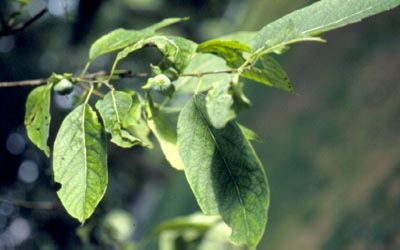Genus: Diospyros

Photo © by Steven Clemants
Taken at the Brooklyn Botanic Garden, NY, 1999.
Nomenclature
Diospyros L., Sp. Pl. 1057. 1753. Gen. Pl. 478. 1754. Guaiacana Duhamel, Traité Arbr. Arbust. 1: 283. 1755, nom. illeg. (Art. 52.1). LECTOTYPE: Diospyros lotus L., designated by Britton & Brown (1913).Persimon Raf., Sylva Tellur. 164. 1838. TYPE: Persimon virginiana (L.) Raf. ex. B.D. Jacks., Index. Kew. 2: 474. 1894. (=Diospyros virginiana L.).
List of Diospyros Species
References to Diospyros
- Alabama Forestry Comission; Anonymous 2003. Common persimmon, Diospyros virginina L.
- Anjaneyulu, C.; Lakshminarayana, K. 1989. Microsporogenesis and the development of male gametophyte in two species of Diospyros L. Taiwania 34: 187-191.
- Anonymous 1871. New stations. Bull. Torrey Bot. Club 2: 28.
- Anonymous 1973. Persimmon, Diospyros virginiana. Morton Arbor. Quart. 9(1): 14-5.
- Baldwin, J. T. 1949. Mistletoe on persimmon. Rhodora 51(605): 105-6.
- Baldwin, J. T.; Culp, R. 1941. Polyploidy in Diospyros virginiana. Amer. J. Bot. 28: 942-4.
- Blomquist, H. L. 1923. Dormancy in the seeds of the persimmon. J. Elisha Mitchell Sci. Soc. 39: 83-5.
- Coladoanto, M. 1992. Diospyros virginiana. ()
- Cristoffer, C. 1993. Fruit removal and interplant distance in the persimmon, Diospyros virginiana. Florida Scientist 56: 223-225.
- Croxton, W. C. 1939. A study of the tolerance of trees to breakage by ice accumulation. Ecology 20: 71-3. (spp. table reprinted in Arborist's News 4(3):24. 1939.)
- Cuno, J. B. 1926. Utilization of dogwood and persimmon. U.S.D.A. Dept. Bull. 1436: 1-43.
- Cypher, B. L.; Cypher, E. A. 1999. Germination rates of tree seeds ingested by coyotes and raccoons. Amer. Midl. Naturalist 142: 71-76.
- Eddy, C. O. 1927. The place of the native persimmon in nature, in relation to other plant communities, and to certain economic insects. Ohio J. Science 27: 187-99.
- Fletcher, W. F. 1942. The native persimmon. (revised)
- Fletcher, W. F. 1915. The native persimmon. (Revised 1928, 24 pp.)
- Goodell, E. 1982. Two promising fruit plants for northern landscape. Arnoldia (Jamaica Plain) 42: 102-33.
- Hague, S. M. 1911. A morphological study of Diospyros virginiana. Bot. Gaz. 52: 34-44.
- Hiern, W. P. 1873. A monograph of the Ebenaceae. Trans. Cambridge Phil. Soc. 12: 27-300.
- Hockman, J. G.; Chapman, J. A. 1983. Comparative feeding habits of red foxes and gray foxes in Maryland. Amer. Midl. Naturalist 110: 276-285.
- Holm, T. 1909. Medicinal plants of North America, No. 31: Diospyros virginiana L. Merck Rep. 18: 229-31.
- Hovrat, R. J. et.al. 1991. Volatile compounds from the mesocarp of persimmons. J. Food Sci. 56: 262-263.
- Knapp, A. K.; Carter, G. A. 1998. Variability in leaf optical properties among 26 species from a broad range of habitats. Amer. J. Bot. 85: 940-946.
- Lloyd, F. E. 1911. The tannin-colloid complexes in the fruit of the persimmon, Diospyos. Biochem. Bull. 1: 7-41.
- Lloyd, F. E. 1911. The behavior of tannin in persimmons with some notes on ripening. Pl. World 14: 1-14.
- Maisenhelder, L. C. 1971. Common persimmon (Diospyros virginiana).
- Mallavadhani, U. V.; Panda, A. K.; Rao, Y. R. 1998. Pharmacology and chemotaxonomy of Diospyros. Phytochemistry 49: 901-951.
- McKenney, T. C. 1967. Differentiation of sterile specimens of Nyssa sylvatica Marsh. and Diospyros virginiana L. Castanea 32: 186-9.
- Miller, E. S. 1871. New stations. Bull. Torrey Bot. Club 2: 31.
- Mottier, D. M. 1913. Further notes on the seedless fruits of the common persimmon - Diospyros virginiana. Proc. Indiana Acad. Sci. 1912: 67-8.
- Plants for a Future Database Committee; Anonymous 2003. Plants for a future database.
- Plumb, C. S. 1896. The American persimmon. Gard. & Forest 9: 442-3.
- Sargent, C. S. 1894. Diospyros. Silva N. Am. 6: 1-12.
- Sargent, C. S. 1921. Notes on North American trees. VIII. J. Arnold Arbor 2: 164-174.
- Shukla, Y. N.; Kapadia, G. J. 1989. Chemical constituents of {Diospyros virginiana. Indian J. Pharm. Sci. 51: 73.
- Skallerup, H. R. 1953. The distribution of Diospyros virginiana L. Ann. Missouri Bot. Gard. 40: 211-25.
- Skallerup, H. R. 1953. Our self-pruning persimmon (Diospyros virginiana). Ann. Missouri Bot. Gard. 41: 39-40.
- Small, J. K. 1918. Diospyros virginiana. Addisonia 3: 9-10.
- Spongberg, S. A. 1977. Ebenaceae hardy in temperate North America. J. Arnold Arbor. 58(2): 146-60.
- Spongberg, S. A. 1991. Notes on persimmons, kakis, date plums, and chapotes. Arnoldia (Jamaica Plain) 51: 47-54. (Reprint from Arnoldia 39(5):290-309. 1979.)
- Sugiura, A. et.al. 1998. Pollen nuclear number in four Diospyros species. Hortscience 33: 149-150.
- Tamura, M. et.al. 1998. Ploidy level and genome size of several Diospyros species. J. Jap. Soc. Hort. Sci. 67: 306-312.
- Troop, J.; Hadley, O. M. 1896. The American persimmon.
- Uphof, J. C. T. 1937. The persimmon in the southern states of North America. Tropenpflanzer 40: 479-83. (In German)
- Watts, R. L. 1899. Persimmons. Univ. Tennesse Agr. Exp. Sta. Bull. 11: 193-223.
- Wood, C. E.; Channell, R. B. 1960. The genera of the Ebenales in the southeastern United States. J. Arnold Arbor. 41: 1-35.
- Woodburn, W. L. 1909. Notes on the native seedless persimmon. Proc. Indiana Acad. Sci. 1908: 99-101.
- Woodburn, W. L. 1911. Development of the embryo sac and endosperm in some seedless persimmons. Bull. Torrey Bot. Club 38: 379-84.
- Yonemori, K. et.al. 1996. RFLP analysis of an amplified region of cpDNA for phylogeny of the genus Diospyros. J. Jap. Soc. Hort. Sci. 64: 771-777.